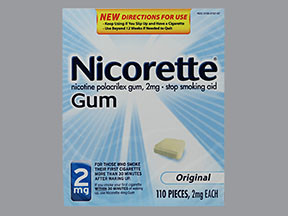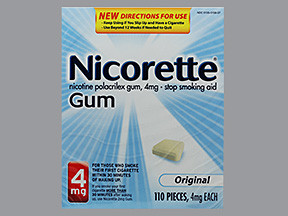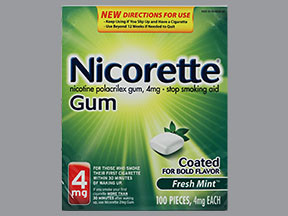NICOTINE GUM - BUCCAL
PHONETIC PRONUNCIATION: (NIK-oh-teen)
COMMON BRAND NAME(S): Nicorette
GENERIC NAME(S): nicotine polacrilex
Uses
USES: This medication can help you quit smoking by replacing the nicotine in cigarettes. The nicotine in tobacco is an important part of cigarette addiction. When you stop smoking, your nicotine levels drop quickly. This drop can cause withdrawal symptoms such as craving tobacco, nervousness, irritability, headache, weight gain, and difficulty concentrating. Stopping smoking is hard and your chance of success is best when you are ready and have made a commitment to quit. Nicotine replacement products are part of a total stop-smoking program that includes behavior change, counseling, and support. Smoking causes lung disease, cancer, and heart disease. Stopping smoking is one of the most important things you can do to improve your health and live longer.
How to use NICOTINE GUM - BUCCAL
HOW TO USE: If you are using the over-the-counter product, read all directions on the product package before using this medication. If your doctor has prescribed this medication, read the Patient Information Leaflet if provided by your pharmacist before you start using this product and each time you get a refill. If you have any questions, consult your doctor or pharmacist. Do not eat or drink anything for 15 minutes before or during use of the gum. Do not use if the individual wrapper is open or damaged. Start this medication on your quit (smoking) day. Chew a piece of gum when you feel the urge to smoke. Chew the gum very slowly until it tingles, then move it to the space between your cheek and gum. Keep it there until it stops tingling. When the tingle is gone, begin chewing again until the tingle returns. Most of the nicotine will be gone after 30 minutes. Do not use more than 1 piece of gum at a time. You may also use this product on a regular schedule as well as at times when you have the urge to smoke. The best dose for you is the dose that decreases the urge to smoke without side effects from too much nicotine. Your dose will need to be adjusted to your needs, including your smoking history and medical condition. For the first 6 weeks, use at least 9 pieces each day. If you still have a strong urge to smoke, you can use a second piece of gum within 1 hour. Do not continuously use 1 piece right after another. Doing so will increase side effects such as hiccups, nausea, or heartburn. Most people use about 9 to 12 pieces of gum per day during the first month of treatment. Do not chew more than 24 pieces of gum a day. After you have stopped smoking and you have reached the best dose and schedule for you, continue at that dose. Start to lower your dose after 6 weeks or as directed by your doctor until you are no longer smoking and no longer need nicotine replacement. It is important to complete the treatment with this medication (12 weeks). If after the treatment period, you still feel the need to use this medication to prevent you from smoking, talk to your doctor. This medication may cause withdrawal reactions, especially if it has been used regularly for a long time or in high doses. In such cases, withdrawal symptoms (such as tobacco cravings, nervousness, irritability, headache) may occur if you suddenly stop using this medication. To prevent withdrawal reactions, your doctor may reduce your dose gradually. Consult your doctor or pharmacist for more details, and report any withdrawal reactions right away. Some smokers are unsuccessful the first time they try to quit. You may need to stop using this product and try again later. Many people who cannot quit the first time are successful the next time.
Side Effects
Precautions
Interactions
Overdose
Images
Reviews
Disclaimer
IMPORTANT: HOW TO USE THIS INFORMATION: This is a summary and does NOT have all possible information about this product. This information does not assure that this product is safe, effective, or appropriate for you. This information is not individual medical advice and does not substitute for the advice of your health care professional. Always ask your health care professional for complete information about this product and your specific health needs.




No Reviews Yet